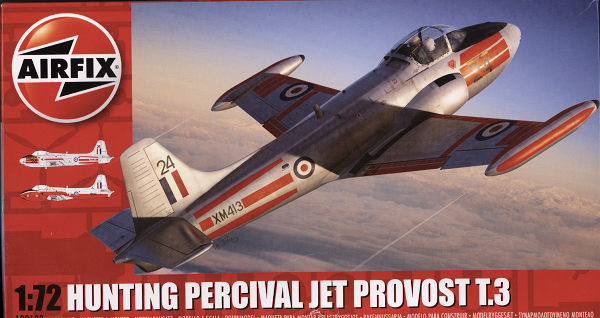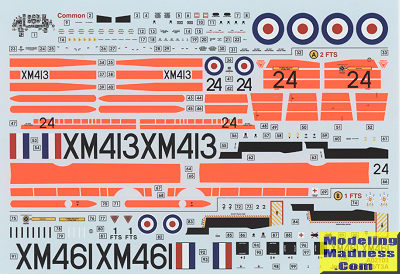
Airfix 1/72 Jet Provost T.3
| KIT #: | A02103 |
| PRICE: | $10.00 for both |
| DECALS: | Two options |
| REVIEWER: | Scott Van Aken |
| NOTES: | 2016 new tool |

| HISTORY |
| THE KIT |
 Continuing
with their 'replacement' policy, Airfix has brought out a new tool kit of
their Jet Provost T.3. Now I know that this is pretty much a 'ho-hum' to
many, but the British market will scarf this one up and probably has
already.
Continuing
with their 'replacement' policy, Airfix has brought out a new tool kit of
their Jet Provost T.3. Now I know that this is pretty much a 'ho-hum' to
many, but the British market will scarf this one up and probably has
already.
Molding is what we have come to expect from a modern Airfix kit and sure beats the original in every way. The cockpit contains the usual control sticks with a center console. Each of the seats is made up of four parts (three if you are installing the crew figures), and has molded on seat harness. There is a decal for the instrument panel.
When trapping this in the fuselage halves, be sure to add nose weight. Much of the nose gear well is molded to the bottom of the cockpit section. Wings are a single lower piece with upper halves. Tip tanks are molded onto the halves so modeling this one without them will require some work. Tailplanes are a single piece that slot into the rear fuselage followed by the jet pipe and rudder.
Intakes are nicely done with a section that slides into the housing part way followed by the outer piece. You can build this kit gear up if you so wish and separate gear doors are provided for this. Because the main gear would be a bit wobbly, they are molded in with the gear doors. Airfix provides two canopy pieces. One is for the closed position and the other for the open. I like that Airfix and others provide this feature.
 Instructions
are 3D style and as usual only provide Humbrol paint numbers during
construction. When doing the external schemes, names are also provided. Two
schemes are given. One is with 2FTS in 1967. This is silver with lots of da-glo
and though you cannot tell from the sheet scan, the da-glo is superbly done. The
other is in a scheme some surviving aircraft wore before replacement in red,
white, and light aircraft grey. This scheme being with 1FTS in 1984. The black
nose areas will need to be painted regardless of the scheme you choose. There
are aftermarket sheets out there if you so wish to go that route.
Instructions
are 3D style and as usual only provide Humbrol paint numbers during
construction. When doing the external schemes, names are also provided. Two
schemes are given. One is with 2FTS in 1967. This is silver with lots of da-glo
and though you cannot tell from the sheet scan, the da-glo is superbly done. The
other is in a scheme some surviving aircraft wore before replacement in red,
white, and light aircraft grey. This scheme being with 1FTS in 1984. The black
nose areas will need to be painted regardless of the scheme you choose. There
are aftermarket sheets out there if you so wish to go that route.
| CONCLUSIONS |
| REFERENCES |
Back to the Main Page Back to the Previews Index Page
Back to the Previews Index Page